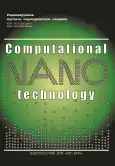Features of the Electrical Properties of Heterojunctions n-GaAs-p-(GaAs)1 - x - у(Ge2)x(ZnSe)y
- Autores: Zaynabidinov S.Z.1, Boboev A.Y.1, Abdurahimov D.P.1
-
Afiliações:
- Andijan State University
- Edição: Volume 9, Nº 2 (2022)
- Páginas: 73-79
- Seção: Articles
- URL: https://journal-vniispk.ru/2313-223X/article/view/147138
- DOI: https://doi.org/10.33693/2313-223X-2022-9-2-73-79
- ID: 147138
Citar
Resumo
Texto integral
##article.viewOnOriginalSite##Sobre autores
Sirajiddin Zaynabidinov
Andijan State University
Email: prof_sirojiddin@mail.ru
доктор физико-математических наук, академик Академии Наук Республики Узбекистан; профессор Andijan, Republic of Uzbekistan
Akramjon Boboev
Andijan State University
Email: boboevscp@gmail.com
кандидат физико-математических наук; доцент Andijan, Republic of Uzbekistan
Dilhayotjon Abdurahimov
Andijan State University
Email: dilhayota@gmail.com
докторант Andijan, Republic of Uzbekistan
Bibliografia
- Saidov M.S. Electroactivity of isovalent impurities and photovoltaic effect. Solar Engineering. 2005. No. 3. Pp. 67-72. (In Rus.)
- Londos C.A., Sgourou E.N., Hall D., Chroneos A. Vacancy-oxygen defects in silicon: the impact of isovalent doping // J. Mater Sci: Mater Electron. 2014. Vol. 25 (6). Pp. 2395-2410.
- Pashartis C., Rubel O. Localization of electronic states in III-V semiconductor alloys: A comparative study // Physical Review Applied. 2017. Vol. 7 (6). Pp. 064011-(1-12).
- Saidov A.S., Razzakov A.Sh., Risaeva V.A., Koschanov E.A. Liquid-phase epitaxy of solid solutions (Ge2)1 - x(ZnSe)x // Materials Chemistry and Physics. 2001. Vol. 68 (1-3). Pр. 1-6.
- Usmonov Sh.N. Interaction of impurities in solid solutions based on silicon, gallium arsenide, zinc selenide, cadmium sulphide and electrophysical properties of heterostructures obtained on their basis: Dis. ... Dr. Sci. (Phys.-Math.). Tashkent: FTI, 2018. 220 p.
- Maronchuk I.E., Kuljutkina T.F., Maronchuk I.I., Bykovskij S.Ju. Liquid-phase epitaxy and properties of nanoheterostructures based on compounds III-V. Nanosystems, Nanomate- rials, Nanotechnologies. 2012. Vol. 10 (1). Pp. 77-88. (In Rus.)
- Bahadirhanov M.K., Ortikov I.B. Small encyclopedic dictionary of semiconductor materials. Tashkent, 2006.
- Katerinchuk V.N., Kudrinskij Z.R., Homjak V.V. et al. Electrical and photoelectric properties of anisotypic heterojunctions n-CdO-p-InSe. Physics and Technology of Semiconductors. 2013. Vol. 47. Issue 7. Pp. 935-938. (In Rus.)
- Zajnabidinov S.Z., Boboev A.J., Lejderman A.Ju. Investigation of current transfer mechanisms in n-GaAs- p-(GaAs)1 - x - y(Ge2)x(ZnSe)y heterostructures. Uzbek Physical Journal. 2019. No. 1. Pp. 14-21.
- Ashith V.K., Priya K., Rao G.K. The electrical properties of n-CdS/p-CdTe and n-ZnS/p-CdTe heterojunctions fabricated by a combination of SILAR and vacuum deposition techniques // Physica B: Condensed Matter. 2021. No. 614. P. 413025.
- Muzafarova S.A., Mirsagatov Sh.A., Zhanabergenov Zh. The mechanism of current transfer in n-CdS/p-CdTe heterojunctions. Solid State Physics. 2007. Vol. 49. Issue 6. Pp. 1111-1116.
- Goutam Kumar Dalapati et al. Defect analysis and performance evaluation of p-type epitaxial GaAs layer on Ge substrate for GaAs/Ge based advanced device // Adv. Mater. Lett. 2016. No. 7 (7). Pp. 517-524.
- Shih-Hsuan Tang et al. Ge epitaxial films on GaAs (100), (110), and (111) substrates for applications of CMOS heterostructural integrations // Journal of Vacuum Science & Technology B. 2013. No. 31. P. 021203.
- Chen Weidong. Gallium arsenide (100) and zinc selenide (100): Surfaces and interfaces with metals: Dis. ... Cand. Sci. (Philos.). Princeton University, 1995. P. 9528916.
- Boboev A.Y., Kalanov M.U., Zainabidinov S.Z. et al. Research of current transport mechanism in n-GaAs-p-(GaAs)1 - x - y (Ge2)x(ZnSe)y heterostructure at various temperatures // Доклады Академии наук PУз. 2016. № 6. С. 43-45.
Arquivos suplementares








